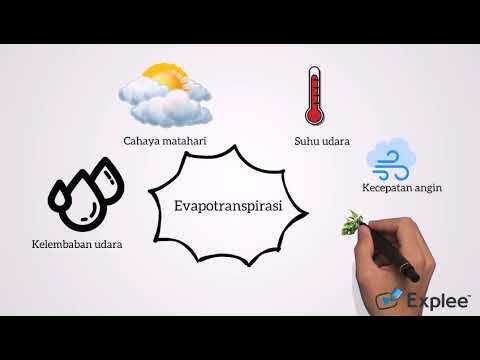Hidrologi - Evaporasi dan Evapotranspirasi
Summary
TLDRThis educational video delves into the hydrological processes of evaporation, transpiration, and evapotranspiration. It explains how water transitions from liquid to vapor, affecting the atmosphere. Key factors influencing evaporation, such as solar radiation, temperature, and wind speed, are discussed. The video also covers various methods for measuring evaporation, including the use of evaporation pans and lysimeters, and introduces formulas by Penman and others for calculating potential evapotranspiration. It's an informative resource for understanding water's journey from Earth's surface to the atmosphere.
Takeaways
- 💧 The script discusses hydrology, specifically focusing on evapotranspiration, which includes evaporation, transpiration, and the combined process of both.
- 🌊 'Evaporation' refers to the process where liquid water turns into water vapor and enters the atmosphere, occurring on the surfaces of bodies of water like seas, lakes, and rivers.
- 🌿 'Transpiration' is the process where water absorbed by plants is released into the atmosphere through the leaves.
- 🌍 'Evapotranspiration' is a term used when evaporation and transpiration are combined, representing the water loss from the land surface due to these processes.
- 🔍 Factors affecting evaporation include solar radiation, temperature, air humidity, and wind speed, all of which influence the rate at which water evaporates.
- 🌡️ Solar radiation is the primary heat source for evaporation, with its intensity varying throughout the year based on latitude, longitude, and season.
- 🌡️ Temperature's effect on evaporation is direct; higher temperatures increase the air's capacity to absorb water and the kinetic energy of water molecules.
- 🌬️ Wind speed is crucial for evaporation as it replaces the saturated air above the water surface with drier air, thus facilitating the process.
- 📏 Methods to measure evaporation include the use of evaporation pans, lysimeters, and the application of formulas based on Dalton's law of diffusion and other empirical equations.
- 🌤️ The Penman method, a combination of mass transfer and energy balance methods, is commonly used to calculate potential evapotranspiration and involves various气象 factors.
Q & A
What are the three main components of evapotranspiration discussed in the script?
-The three main components of evapotranspiration discussed are evaporation (Inol), transpiration (ITB), and evapotranspiration (ET) which combines both processes.
How is evaporation defined in the context of hydrology?
-Evaporation in hydrology is defined as the process where liquid water turns into water vapor and enters the atmosphere, specifically occurring on the surface of bodies of water like seas, lakes, rivers, and ponds.
What is transpiration and how does it relate to plants?
-Transpiration is the process by which water is absorbed by plant roots and then transported through the plant's stem to the leaves where it evaporates into the atmosphere. It is a critical component of the water cycle in plants.
What factors influence evaporation as mentioned in the script?
-The factors influencing evaporation mentioned in the script include solar radiation, temperature, atmospheric pressure, humidity, and wind speed.
What is the significance of the term 'evapotranspiration potential' in the script?
-Evapotranspiration potential refers to the rate of evapotranspiration that would occur if water is not limited, which depends on the availability of water and the atmosphere's ability to evaporate the water.
How is the rate of evaporation measured in terms of volume?
-The rate of evaporation is measured as the volume of water lost due to evaporation per unit area and unit time, typically expressed in millimeters per day or per month.
What are the methods used to estimate evaporation as described in the script?
-The methods used to estimate evaporation include using evaporation pans, lysimeters, water balance equations, and various empirical formulas such as the Penman method.
What is the role of the Dalton's law of diffusion in the context of evaporation?
-Dalton's law of diffusion is used to describe the relationship between evaporation and the difference between the vapor pressure of the air and the saturated vapor pressure, which is influenced by air humidity.
Can you explain the concept of 'lysimeter' as it is used in the script?
-A lysimeter is a device used to measure actual evapotranspiration by simulating natural conditions. It must represent the surrounding environment, including plant cover, soil surface texture, porosity, and permeability.
What is the Penman method and how is it used in calculating evapotranspiration?
-The Penman method is a widely used approach to calculate potential evapotranspiration by combining mass transfer and energy balance principles. It involves calculations based on net radiation, air temperature, and wind speed to estimate the rate of evapotranspiration.
Outlines

هذا القسم متوفر فقط للمشتركين. يرجى الترقية للوصول إلى هذه الميزة.
قم بالترقية الآنMindmap

هذا القسم متوفر فقط للمشتركين. يرجى الترقية للوصول إلى هذه الميزة.
قم بالترقية الآنKeywords

هذا القسم متوفر فقط للمشتركين. يرجى الترقية للوصول إلى هذه الميزة.
قم بالترقية الآنHighlights

هذا القسم متوفر فقط للمشتركين. يرجى الترقية للوصول إلى هذه الميزة.
قم بالترقية الآنTranscripts

هذا القسم متوفر فقط للمشتركين. يرجى الترقية للوصول إلى هذه الميزة.
قم بالترقية الآنتصفح المزيد من مقاطع الفيديو ذات الصلة
5.0 / 5 (0 votes)






